Solar eclipse of September 21, 1922 (original) (raw)
From Wikipedia, the free encyclopedia
Total eclipse
| Solar eclipse of September 21, 1922 | |
|---|---|
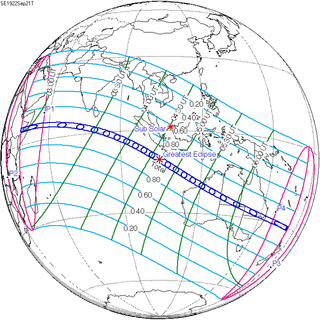 Map Map |
|
| Type of eclipse | |
| Nature | Total |
| Gamma | −0.213 |
| Magnitude | 1.0678 |
| Maximum eclipse | |
| Duration | 359 s (5 min 59 s) |
| Coordinates | 10°42′S 104°30′E / 10.7°S 104.5°E / -10.7; 104.5 |
| Max. width of band | 226 km (140 mi) |
| Times (UTC) | |
| Greatest eclipse | 4:40:31 |
| References | |
| Saros | 133 (40 of 72) |
| Catalog # (SE5000) | 9333 |
A total solar eclipse occurred at the Moon's ascending node of orbit on Thursday, September 21, 1922,[1] with a magnitude of 1.0678. A solar eclipse occurs when the Moon passes between Earth and the Sun, thereby totally or partly obscuring the image of the Sun for a viewer on Earth. A total solar eclipse occurs when the Moon's apparent diameter is larger than the Sun's, blocking all direct sunlight, turning day into darkness. Totality occurs in a narrow path across Earth's surface, with the partial solar eclipse visible over a surrounding region thousands of kilometres wide. Occurring about 2 hours after perigee (on September 21, 1922, at 6:30 UTC), the Moon's apparent diameter was larger.[2] Perigee did occur as the eclipse was past its greatest eclipse.
Totality started in Ethiopia, Italian Somaliland (today's Somalia), and passed British Maldives and Christmas Island in the Straits Settlements (now in Australia) in the Indian Ocean, and Australia. A partial eclipse was visible for parts of East Africa, South Asia, Southeast Asia, Australia, and Oceania.
Observations of the total solar eclipse of May 29, 1919 got results consistent with gravitational lens proposed by Einstein's general relativity. To reconfirm the result, observatories in South Australia and New South Wales each organized a large scientific expedition. A total of 20 teams went to sparsely populated Wallal on the northern coast of Western Australia. Among them, the American team from the Lick Observatory arrived in Sydney on August 5, took a train westward and arrived in Perth on August 16. The team took a ship on August 20 from Fremantle, a port southwest of Perth, to Broome, and then finally arrived at Wallal. Although not organizing any observations, the Australian government provided financial support to the teams. For example, the round-trip travel expenses between Sydney and Wallal were paid by the federal government.[3][4]
Shown below are two tables displaying details about this particular solar eclipse. The first table outlines times at which the moon's penumbra or umbra attains the specific parameter, and the second table describes various other parameters pertaining to this eclipse.[5]
September 21, 1922 Solar Eclipse Times
| Event | Time (UTC) |
|---|---|
| First Penumbral External Contact | 1922 September 21 at 02:04:28.6 UTC |
| First Umbral External Contact | 1922 September 21 at 02:58:45.3 UTC |
| First Central Line | 1922 September 21 at 03:00:06.4 UTC |
| First Umbral Internal Contact | 1922 September 21 at 03:01:27.5 UTC |
| First Penumbral Internal Contact | 1922 September 21 at 03:57:50.9 UTC |
| Ecliptic Conjunction | 1922 September 21 at 04:38:20.9 UTC |
| Greatest Duration | 1922 September 21 at 04:40:07.8 UTC |
| Greatest Eclipse | 1922 September 21 at 04:40:31.1 UTC |
| Equatorial Conjunction | 1922 September 21 at 04:47:31.9 UTC |
| Last Penumbral Internal Contact | 1922 September 21 at 05:23:00.2 UTC |
| Last Umbral Internal Contact | 1922 September 21 at 06:19:29.4 UTC |
| Last Central Line | 1922 September 21 at 06:20:50.6 UTC |
| Last Umbral External Contact | 1922 September 21 at 06:22:11.7 UTC |
| Last Penumbral External Contact | 1922 September 21 at 07:16:30.2 UTC |
September 21, 1922 Solar Eclipse Parameters
| Parameter | Value |
|---|---|
| Eclipse Magnitude | 1.06783 |
| Eclipse Obscuration | 1.14026 |
| Gamma | −0.21299 |
| Sun Right Ascension | 11h50m29.6s |
| Sun Declination | +01°01'49.3" |
| Sun Semi-Diameter | 15'56.0" |
| Sun Equatorial Horizontal Parallax | 08.8" |
| Moon Right Ascension | 11h50m13.7s |
| Moon Declination | +00°49'23.8" |
| Moon Semi-Diameter | 16'43.8" |
| Moon Equatorial Horizontal Parallax | 1°01'24.1" |
| ΔT | 22.8 s |
This eclipse is part of an eclipse season, a period, roughly every six months, when eclipses occur. Only two (or occasionally three) eclipse seasons occur each year, and each season lasts about 35 days and repeats just short of six months (173 days) later; thus two full eclipse seasons always occur each year. Either two or three eclipses happen each eclipse season. In the sequence below, each eclipse is separated by a fortnight.
Eclipse season of September–October 1922
| September 21Ascending node (new moon) | October 6Descending node (full moon) |
|---|---|
 |
 |
| Annular solar eclipseSolar Saros 133 | Penumbral lunar eclipseLunar Saros 145 |
- A penumbral lunar eclipse on March 13.
- An annular solar eclipse on March 28.
- A penumbral lunar eclipse on April 11.
- A total solar eclipse on September 21.
- A penumbral lunar eclipse on October 6.
- Preceded by: Solar eclipse of December 3, 1918
- Followed by: Solar eclipse of July 9, 1926
- Preceded by: Solar eclipse of August 10, 1915
- Followed by: Solar eclipse of November 1, 1929
- Preceded by: Lunar eclipse of September 15, 1913
- Followed by: Lunar eclipse of September 26, 1931
- Preceded by: Solar eclipse of October 22, 1911
- Followed by: Solar eclipse of August 21, 1933
- Preceded by: Solar eclipse of September 9, 1904
- Followed by: Solar eclipse of October 1, 1940
- Preceded by: Solar eclipse of October 9, 1893
- Followed by: Solar eclipse of September 1, 1951
- Preceded by: Solar eclipse of November 20, 1835
- Followed by: Solar eclipse of July 22, 2009
Solar eclipses of 1921–1924
[edit]
This eclipse is a member of a semester series. An eclipse in a semester series of solar eclipses repeats approximately every 177 days and 4 hours (a semester) at alternating nodes of the Moon's orbit.[6]
The partial solar eclipse on July 31, 1924 occurs in the next lunar year eclipse set.
| Solar eclipse series sets from 1921 to 1924 | |||||
|---|---|---|---|---|---|
| Descending node | Ascending node | ||||
| Saros | Map | Gamma | Saros | Map | Gamma |
| 118 | April 8, 1921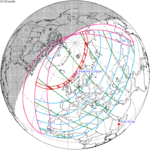 Annular Annular |
0.8869 | 123 | October 1, 1921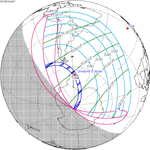 Total Total |
−0.9383 |
| 128 | March 28, 1922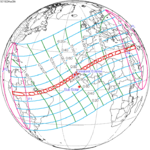 Annular Annular |
0.1711 | 133 | September 21, 1922 Total Total |
−0.213 |
| 138 | March 17, 1923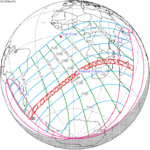 Annular Annular |
−0.5438 | 143 | September 10, 1923 Total Total |
0.5149 |
| 148 | March 5, 1924 Partial Partial |
−1.2232 | 153 | August 30, 1924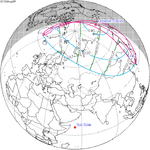 Partial Partial |
1.3123 |
This eclipse is a part of Saros series 133, repeating every 18 years, 11 days, and containing 72 events. The series started with a partial solar eclipse on July 13, 1219. It contains annular eclipses from November 20, 1435 through January 13, 1526; a hybrid eclipse on January 24, 1544; and total eclipses from February 3, 1562 through June 21, 2373. The series ends at member 72 as a partial eclipse on September 5, 2499. Its eclipses are tabulated in three columns; every third eclipse in the same column is one exeligmos apart, so they all cast shadows over approximately the same parts of the Earth.
The longest duration of annularity was produced by member 25 at 1 minutes, 14 seconds on November 30, 1453, and the longest duration of totality was produced by member 61 at 6 minutes, 50 seconds on August 7, 1850. All eclipses in this series occur at the Moon’s ascending node of orbit.[7]
| Series members 34–55 occur between 1801 and 2200: | ||
|---|---|---|
| 34 | 35 | 36 |
 July 17, 1814 July 17, 1814 |
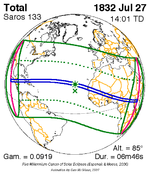 July 27, 1832 July 27, 1832 |
 August 7, 1850 August 7, 1850 |
| 37 | 38 | 39 |
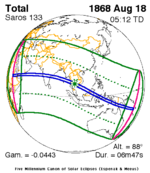 August 18, 1868 August 18, 1868 |
 August 29, 1886 August 29, 1886 |
 September 9, 1904 September 9, 1904 |
| 40 | 41 | 42 |
 September 21, 1922 September 21, 1922 |
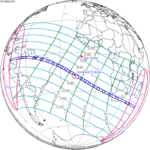 October 1, 1940 October 1, 1940 |
 October 12, 1958 October 12, 1958 |
| 43 | 44 | 45 |
 October 23, 1976 October 23, 1976 |
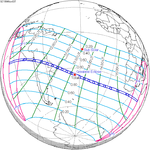 November 3, 1994 November 3, 1994 |
 November 13, 2012 November 13, 2012 |
| 46 | 47 | 48 |
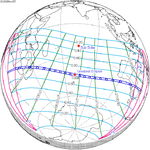 November 25, 2030 November 25, 2030 |
 December 5, 2048 December 5, 2048 |
 December 17, 2066 December 17, 2066 |
| 49 | 50 | 51 |
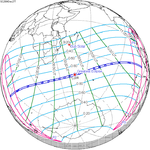 December 27, 2084 December 27, 2084 |
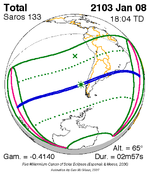 January 8, 2103 January 8, 2103 |
 January 19, 2121 January 19, 2121 |
| 52 | 53 | 54 |
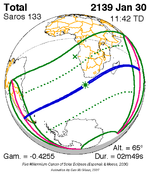 January 30, 2139 January 30, 2139 |
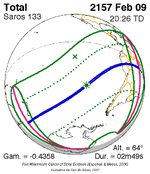 February 9, 2157 February 9, 2157 |
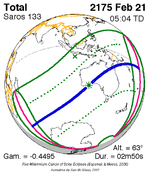 February 21, 2175 February 21, 2175 |
| 55 | ||
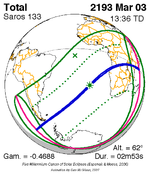 March 3, 2193 March 3, 2193 |
The metonic series repeats eclipses every 19 years (6939.69 days), lasting about 5 cycles. Eclipses occur in nearly the same calendar date. In addition, the octon subseries repeats 1/5 of that or every 3.8 years (1387.94 days). All eclipses in this table occur at the Moon's ascending node.
| 22 eclipse events between December 2, 1880 and July 9, 1964 | ||||
|---|---|---|---|---|
| December 2–3 | September 20–21 | July 9–10 | April 26–28 | February 13–14 |
| 111 | 113 | 115 | 117 | 119 |
 December 2, 1880 December 2, 1880 |
 July 9, 1888 July 9, 1888 |
 April 26, 1892 April 26, 1892 |
 February 13, 1896 February 13, 1896 |
|
| 121 | 123 | 125 | 127 | 129 |
 December 3, 1899 December 3, 1899 |
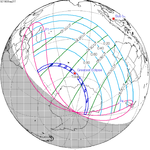 September 21, 1903 September 21, 1903 |
 July 10, 1907 July 10, 1907 |
 April 28, 1911 April 28, 1911 |
 February 14, 1915 February 14, 1915 |
| 131 | 133 | 135 | 137 | 139 |
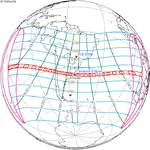 December 3, 1918 December 3, 1918 |
 September 21, 1922 September 21, 1922 |
 July 9, 1926 July 9, 1926 |
 April 28, 1930 April 28, 1930 |
 February 14, 1934 February 14, 1934 |
| 141 | 143 | 145 | 147 | 149 |
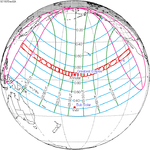 December 2, 1937 December 2, 1937 |
 September 21, 1941 September 21, 1941 |
 July 9, 1945 July 9, 1945 |
 April 28, 1949 April 28, 1949 |
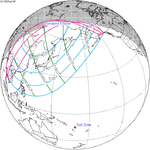 February 14, 1953 February 14, 1953 |
| 151 | 153 | 155 | ||
 December 2, 1956 December 2, 1956 |
 September 20, 1960 September 20, 1960 |
 July 9, 1964 July 9, 1964 |
This eclipse is a part of a tritos cycle, repeating at alternating nodes every 135 synodic months (≈ 3986.63 days, or 11 years minus 1 month). Their appearance and longitude are irregular due to a lack of synchronization with the anomalistic month (period of perigee), but groupings of 3 tritos cycles (≈ 33 years minus 3 months) come close (≈ 434.044 anomalistic months), so eclipses are similar in these groupings.
| Series members between 1801 and 2200 | ||||
|---|---|---|---|---|
 August 28, 1802(Saros 122) August 28, 1802(Saros 122) |
 July 27, 1813(Saros 123) July 27, 1813(Saros 123) |
 June 26, 1824(Saros 124) June 26, 1824(Saros 124) |
 May 27, 1835(Saros 125) May 27, 1835(Saros 125) |
 April 25, 1846(Saros 126) April 25, 1846(Saros 126) |
 March 25, 1857(Saros 127) March 25, 1857(Saros 127) |
 February 23, 1868(Saros 128) February 23, 1868(Saros 128) |
 January 22, 1879(Saros 129) January 22, 1879(Saros 129) |
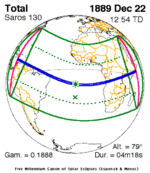 December 22, 1889(Saros 130) December 22, 1889(Saros 130) |
 November 22, 1900(Saros 131) November 22, 1900(Saros 131) |
 October 22, 1911(Saros 132) October 22, 1911(Saros 132) |
 September 21, 1922(Saros 133) September 21, 1922(Saros 133) |
 August 21, 1933(Saros 134) August 21, 1933(Saros 134) |
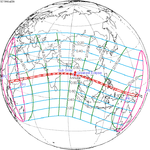 July 20, 1944(Saros 135) July 20, 1944(Saros 135) |
 June 20, 1955(Saros 136) June 20, 1955(Saros 136) |
 May 20, 1966(Saros 137) May 20, 1966(Saros 137) |
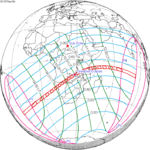 April 18, 1977(Saros 138) April 18, 1977(Saros 138) |
 March 18, 1988(Saros 139) March 18, 1988(Saros 139) |
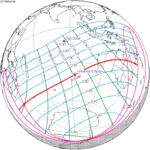 February 16, 1999(Saros 140) February 16, 1999(Saros 140) |
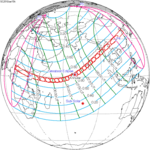 January 15, 2010(Saros 141) January 15, 2010(Saros 141) |
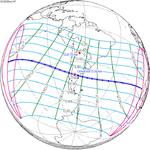 December 14, 2020(Saros 142) December 14, 2020(Saros 142) |
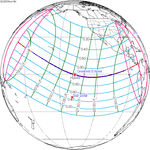 November 14, 2031(Saros 143) November 14, 2031(Saros 143) |
 October 14, 2042(Saros 144) October 14, 2042(Saros 144) |
 September 12, 2053(Saros 145) September 12, 2053(Saros 145) |
 August 12, 2064(Saros 146) August 12, 2064(Saros 146) |
 July 13, 2075(Saros 147) July 13, 2075(Saros 147) |
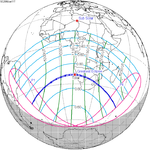 June 11, 2086(Saros 148) June 11, 2086(Saros 148) |
 May 11, 2097(Saros 149) May 11, 2097(Saros 149) |
 April 11, 2108(Saros 150) April 11, 2108(Saros 150) |
 March 11, 2119(Saros 151) March 11, 2119(Saros 151) |
 February 8, 2130(Saros 152) February 8, 2130(Saros 152) |
 January 8, 2141(Saros 153) January 8, 2141(Saros 153) |
 December 8, 2151(Saros 154) December 8, 2151(Saros 154) |
 November 7, 2162(Saros 155) November 7, 2162(Saros 155) |
 October 7, 2173(Saros 156) October 7, 2173(Saros 156) |
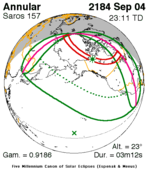 September 4, 2184(Saros 157) September 4, 2184(Saros 157) |
 August 5, 2195(Saros 158) August 5, 2195(Saros 158) |
This eclipse is a part of the long period inex cycle, repeating at alternating nodes, every 358 synodic months (≈ 10,571.95 days, or 29 years minus 20 days). Their appearance and longitude are irregular due to a lack of synchronization with the anomalistic month (period of perigee). However, groupings of 3 inex cycles (≈ 87 years minus 2 months) comes close (≈ 1,151.02 anomalistic months), so eclipses are similar in these groupings.
| Series members between 1801 and 2200 | ||
|---|---|---|
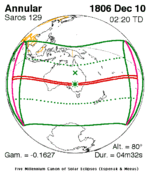 December 10, 1806(Saros 129) December 10, 1806(Saros 129) |
 November 20, 1835(Saros 130) November 20, 1835(Saros 130) |
 October 30, 1864(Saros 131) October 30, 1864(Saros 131) |
 October 9, 1893(Saros 132) October 9, 1893(Saros 132) |
 September 21, 1922(Saros 133) September 21, 1922(Saros 133) |
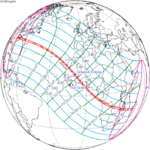 September 1, 1951(Saros 134) September 1, 1951(Saros 134) |
 August 10, 1980(Saros 135) August 10, 1980(Saros 135) |
 July 22, 2009(Saros 136) July 22, 2009(Saros 136) |
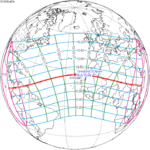 July 2, 2038(Saros 137) July 2, 2038(Saros 137) |
 June 11, 2067(Saros 138) June 11, 2067(Saros 138) |
 May 22, 2096(Saros 139) May 22, 2096(Saros 139) |
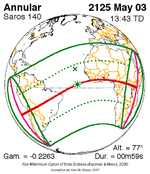 May 3, 2125(Saros 140) May 3, 2125(Saros 140) |
 April 12, 2154(Saros 141) April 12, 2154(Saros 141) |
 March 23, 2183(Saros 142) March 23, 2183(Saros 142) |
- ^ "September 21, 1922 Total Solar Eclipse". timeanddate. Retrieved 2 August 2024.
- ^ "Moon Distances for London, United Kingdom, England". timeanddate. Retrieved 2 August 2024.
- ^ "1922 Solar Eclipse in Australia Testing Einstein's Theory". Retrieved 4 June 2011.
- ^ R. R. Burman & P. M. Jeffery (1990). "Wallal - the 1922 Eclipse Expedition". Proceedings of the Astronomical Society of Australia. 8 (3): 312–313. Archived from the original on 11 February 2021.
- ^ "Total Solar Eclipse of 1922 Sep 21". EclipseWise.com. Retrieved 2 August 2024.
- ^ van Gent, R.H. "Solar- and Lunar-Eclipse Predictions from Antiquity to the Present". A Catalogue of Eclipse Cycles. Utrecht University. Retrieved 6 October 2018.
- ^ "NASA - Catalog of Solar Eclipses of Saros 133". eclipse.gsfc.nasa.gov.
- Fotos of Solar Corona September 21, 1922
- Earth visibility chart and eclipse statistics Eclipse Predictions by Fred Espenak, NASA/GSFC
- 1922 Solar Eclipse in Australia
- Wallal: The 1922 Eclipse Expedition
- Photographs from the Wallal Australia expedition from the Lick Observatory Records Digital Archive, UC Santa Cruz Library's Digital Collections Archived 2016-03-05 at the Wayback Machine